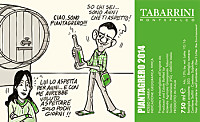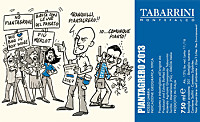|
Think about a red wine. Any wine. Think about your favorite red wine or the
last one you have had. Now forget it completely. The wine and grape I am about
to tell you, in fact, has such unique and particular characteristics, so unique
it cannot be compared to anything else. It is, talking about the grape used for
its making, a variety forgotten for almost a century, rediscovered and revalued
thanks to new and modern viticultural and wine making practices in order to
make it a wine of absolute personality. We are in Umbria, the grape is Grero,
the winery is Tabarrini, the wine is Piantagrero. The name of the wine and the
particular labels used for each vintage do not betray the character and
personality of its producer: non-conformist, multifaceted, volcanic and
standing out from the crowd, in short, Giampaolo Tabarrini. Those who
have the pleasure and privilege of knowing him, and I am one of them, will
certainly agree with me, aware of the exuberance and initiative – obstinate
and stubborn in perfect umbro–montefalchese style – something typical
of Giampaolo Tabarrini.
Ex enfant prodige of the Umbrian wine scene, Giampaolo Tabarrini is
today a successful producer, one of those who has been capable of bringing
Sagrantino, Montefalco, Umbria and Italian wine around the world. Tabarrini
winery is not only committed to Sagrantino, of which makes four labels, but
also to Trebbiano Spoletino – Adarmando, dedicated to the maternal
grandfather – and, in recent years, Grero too. Autochthonous grape of Umbria,
almost forgotten for about a century, Grero – which takes its name from the
union of Greco and Nero (respectively, Italian for Greek
and Black) – is certainly a variety of which we will hear about it
again in the future. Recent studies and research, conducted by the University
of Perugia and by Ciuffelli Agronomy School of Todi, have allowed the
rediscovering of this variety, of which there is very little information,
re-evaluated it through modern viticulture and wine making techniques. It is
believed Grero is an indigenous grape of the territory of Todi – some, for
this reason, call it Grero di Todi – and in the past it was quite
common in the territory of Umbria.
Giampaolo Tabarrini's meeting with Grero took place – so to speak – by pure
chance. Giampaolo Tabarrini himself tells us how it happened: «The story of our
Grero began in 2007 when, without knowing what it was, we find a vine in the
garden of the holiday home of a lady from Rome, not very far from our winery.
As it had been three years since it was last pruned, we offered our help to do
that. A small part of the pruning was sent to the laboratory to identify its
genetic characteristics, and in order to understand what it was, another part
was sent to a nursery for propagation. From the results of the laboratory we
found out it was Grero, an indigenous variety of our area, already known in the
past ampelography of our territory». After having “discovered” Grero, they
had to make a decision about what they could do with it. Giampaolo Tabarrini
continues: «We decided how much to plant and, above all, tried to imagine what
kind of wine could be obtained with Grero, also by considering the existing
documentation about this grape mentioned only the characteristics of the vine,
without giving any information about its wines. We knew it was a late ripening
variety, with a small cluster and berries. We therefore decided to take a risks
and in 2007 we planted half a hectare of Grero, and then, over time, the area
has been increased to one hectare. The first harvesting was in 2013».
Experimentation and the first harvesting allowed them to finally understand
the organoleptic and sensorial qualities of Grero wine. This is what Giampaolo
Tabarrini says about this: «From the organoleptic point of view it is a wine
not recalling any other one. There is no reference grape that can be compared
to Grero. This variety, although being a late ripening grape, makes wines with
a modest alcohol volume. Even in hot years the wine had no more than 13.2% of
alcohol. It has a very high acidity – far from the regional standards – and a
very low PH, figures that in Umbria are not found in red wines. It has a dark,
impenetrable and deep color, deeper than Sagrantino or Colorino. It has no
tannins, therefore Grero wines are much appreciated for their fruit sensations
and crispness». Grero is a surprising grape and, even in terms of longevity, it
seems to be different from other Umbrian grapes. Giampaolo Tabarrini, in this
regard, comments «What is most impressive is its longevity: because of the
small quantity of wine produced, we aged the first two vintages (2013 and
2014) in barrique, something usually accelerating the aging processes of wine.
2013 vintage, after three years and a half in barrique, seems not to have
undergone a significant evolution: it practically remained the same as when we
put it in barrique. This makes us think about a wine not being subject to
oxidation and premature decay. Time will allow us to better understand the
potentials of Grero, however we are confident it is capable of making wines
with a great longevity potential».
Tasting Grero unfolds its remarkable personality and character, different from
any other wine, with uncommon sensorial characteristics when compared to
what you would expect from a red wine, especially Umbrian. We had the
opportunity to taste, by using the “blind” method and something we always do
in our tasting, the three available vintages of Tabarrini's Piantagrero
– 2013, 2014 and 2015 – and the result, as well as being very promising, was
also decidedly exciting. First of all, acidity: pungent, vibrant and lively,
clearly a dominant and pleasing quality of Grero. Do not think about a wine
that is acidic only, as Piantagrero is clearly balanced, both 2013 and 2014
vintages – aged in barrique – and 2015, exclusively aged in steel tanks. Then
astringency: modest and almost imperceptible, however with a good amount of
alcohol – an average of 13% – is very effective in balancing the intense
acidity. Moreover, appearance: red color, redder than any red you could think
of, with a virtually non existing transparency, here light can barely pass
through the glass. Then, nuances: purple red – blue and purplish hues are
clearly seen – even in 2013 vintage, aged for two years in barrique.
The wonders of the Grero are expressed also to the nose, revealing a
particular and unique olfactory profile. On this regard, it should be noted
2015 vintage – aged in steel tanks – obviously gives a very different wine
from 2013 and 2014 vintages, aged in barrique, however expressing qualities
typical and frequent in Grero. The olfactory profile has a strong fruity and
floral personality, as well as revealing aromatic herbs, mineral
characteristics, pleasantly reminiscent of vegetables and spices, the latter
sensations can be especially perceived in vintages aged in steel tanks. An
olfactory perception you would not expect in a red wine is orange which in
Grero is dominant and identifying, making it unique. Finally the structure:
Grero makes wines with a rather modest body, despite the fact the aging in
barrique contributes to increase it substantially.
It is hard, in any case, to tell whether Piantagrero aged in barrique is better
than the one aged in steel tanks. They simply are two wines offering two
distinct interpretations, both interesting for sure, despite the fact it is
evident – and predictable – the aging in steel tanks gives a wine with a more
vibrant acidity and a more lively olfactory freshness. On the other hand, aging
in barrique contributes to the balance of the typical acidity of Grero with a
rounder and warmer character, as well as more complex aromas, to the detriment
of fruit and flower sensations, which are however well perceptible. A matter of
taste, one could say, considering Piantagrero is a wine in evident experimental
stage and still needs study and verification in order to better understand it.
The premises, however, are very promising and of considerable interest.
My hope is Grero will become one of the varieties in which investing for
the future of Umbrian wine making, as it has all the characteristics in order
to make a unique wine to be identified to a territory. A final remark must be
said for the labels, represented by nice cartoons and in which the protagonist
is my friend Giampaolo Tabarrini. Each vintage has a different label: in 2014
we can see Federica, Giampaolo's wife, in 2013 and 2016 he is depicted with
wine maker Emiliano Falsini, in 2015 Giampaolo Tabarrini runs away with a
bottle of Piantagrero. It must be said 2016 vintage does not exist – better to
say, it was not produced – because of the very strict and severe weather
conditions not allowing the vine to give any grape. For this reason, in fact,
in the label of 2016 vintage we see Giampaolo Tabarrini and wine maker Emiliano
Falsini regretting for not having been able to make their Grero wine. The
bottle of Piantagrero 2016, including the label, does exist but it is
sadly empty, in the perfect provocative and surprising style
distinguishing my friend Giampaolo Tabarrini.
Antonello Biancalana

|
Piantagrero 2015 |
| Tabarrini (Umbria, Italy) |
 Grero Grero |
| Price: € 24.00 |
Score:     |
 Deep ruby red and nuances of purple red, little transparency.  Intense, clean, pleasing and refined, starts with hints of blueberry,
plum and black cherry followed by aromas of orange, flint, raspberry,
blackberry, violet, carob, tobacco and pink pepper.
 Low tannic attack with appreciable crispness, however balanced,
light body, intense flavors, agreeable.
 Persistent finish with flavors of blueberry, plum and raspberry.  18 months in steel tanks. |
 Pasta with meat and mushrooms, Stewed meat, Roasted white meat, Legume and mushroom soups Pasta with meat and mushrooms, Stewed meat, Roasted white meat, Legume and mushroom soups |

|
Piantagrero 2014 |
| Tabarrini (Umbria, Italy) |
 Grero Grero |
| Price: € 24.00 |
Score:     |
 Deep ruby red and nuances of purple red, impenetrable to light.  Intense, clean, pleasing and refined, starts with hints of blueberry,
plum and raspberry followed by aromas of violet, orange, black cherry,
blackberry, vanilla, chocolate and rosemary.
 Properly tannic attack with an appreciable crispness, however balanced
by alcohol, good body, intense flavors, agreeable.
 Persistent finish with flavors of blueberry, black cherry and
raspberry.
 2 years in barrique. |
 Stuffed pasta with mushrooms, Stewed meat with mushrooms, Broiled meat and barbecue Stuffed pasta with mushrooms, Stewed meat with mushrooms, Broiled meat and barbecue |

|
Piantagrero 2013 |
| Tabarrini (Umbria, Italy) |
 Grero Grero |
| Price: € 24.00 |
Score:      |
 Intense ruby red and nuances of purple red, little transparency.  Intense, clean, pleasing, refined and elegant, starts with hints of
black cherry, plum and pomegranate followed by aromas of raspberry,
blueberry, orange, blackberry, violet, tobacco, chocolate, vanilla, cumin,
pink pepper, leather and menthol.
 Crisp attack and low astringency, however balanced by alcohol, good
body, intense flavors, agreeable.
 Persistent finish with flavors of black cherry, plum and blueberry.  24 months in barrique. |
 Stuffed pasta with mushrooms, Roasted meat, Stewed meat, Mushroom soups Stuffed pasta with mushrooms, Roasted meat, Stewed meat, Mushroom soups |
|
 | |
| The label of Piantagrero
2016: neverwine | |
|
|



